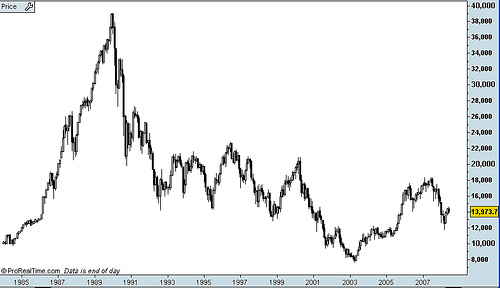121. A Trader's Introduction to the Euro
The Euro is now the official currency of 15 of the 27 member states in the European Union (EU), which makes it the currency used by over 320 Million people. Like Europe itself, the Euro has an interesting history, which we as traders must understand to have a full understanding of the fundamentals of the currency. There are two major factors which lead to the eventual formation of the European Union, and therefore the Euro, which are important for traders to understand.
1. The major powers in Europe had been battling each other for hundreds of years prior to World War II. Nothing like the decimation that the World Wars brought to Europe had ever been seen before however, so after World War II, there was a realization that a drastic reordering of the political landscape was needed, in order to put nationalistic rivalries to bed once and for all. 2. Also as a result of World War II, the world's power structure had shifted, and the major European countries who were once the superpowers of the world, were replaced by two new superpowers. The United States and The Soviet Union were now the unrivaled superpowers of the world, and as a result there was a keen awareness among the former world powers of Europe, that banding together was the only way for Europe to have comparable clout on the world stage. It was primarily as a result of these two factors that the European Coal and Steel Community (which eventually became the European Economic Community, the predecessor to the European Union) was founded in the 1950's with the general goals of:
1. Lowering trade barriers and facilitating economic cooperation for the benefit of the member nations.
2. Increasing Europe's clout on the world stage
3. Integrating the economies of the major countries in Europe to the point where they were too reliant on one another to go to war again. During the next several decades many things happened from a diplomatic and trade standpoint that are very interesting, and which can be read about by doing a search on google for the history of the European Union. The next important event for us as traders however, came with the ratification of something which is known as the Maastricht Treaty in the 1990's. [COLOR=#000000]Up to this point, the idea of a tie up between nations in Europe was primarily focused on removing trade barriers and promoting economic cooperation. With the Maastricht treaty, member countries moved from a simple economic cooperation, to the much grander ambition of political integration between member nations.
This is important to us as traders as it was here that plans for a single currency to be used among member nations was introduced, and therefore here that the basic fundamentals of the Euro were laid out. There were three steps outlined in the Maastricht treaty that had to be completed before the currency could be released which were:
1. Free circulation of capital among member countries.
2. The second, and most important step for us as traders to understand, was the coordination of economic policies. Once the Euro was introduced, each of the member countries would be bound by the monetary policy as set by the European Central Bank. With this in mind, you could not have countries with extremely different levels of inflation and interest rates, replace their currency with the Euro, without undermining the credibility and fundamentals of the currency. To make the currency credible, and to make its introduction as smooth as possible, member countries were required to keep inflation, interest rates, and debt below certain levels. Lastly, they were also required to maintain an exchange rate that was basically a banded peg, allowing their currency to fluctuate only within a narrow band.
3. In 1999 the European Central Bank was established and the eleven countries listed here began to use the Euro in electronic format only.
Spain, Portugal, Italy, Belgium, the Netherlands, Luxembourg, France, Germany, Austria, Ireland and Finland.
These countries formed what is known as the European Monetary Union, which is comprised of countries who are members of the European Union, and use the Euro as their currency.
Greece, the United Kingdom, Sweden, and Denmark (the other members of the European Union at the time) remained outside the European monetary Union for different reasons.
While this may seem a bit like a history lesson rather than a lesson in trading, it is very important for traders of the Euro to have an understanding of the history we have just gone over. As we will learn in coming lessons, it is because of this history that the Euro is where it is today, and many of the concepts we have just outlined still affect the value of the currency in today's market.


 1Likes
1Likes LinkBack URL
LinkBack URL About LinkBacks
About LinkBacks










 Reply With Quote
Reply With Quote



Bookmarks